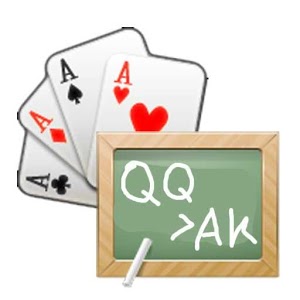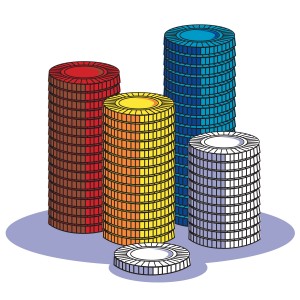An introduction
As I kick off the “On the Draw” column, I suppose I should introduce myself and tell you what this column is about. Some of you might know me from my work as an investment analyst writing about investing in general and gaming industry stocks in particular for the Motley Fool at Fool.com; others are more familiar with my book Pot-Limit Omaha Poker: The Big Play Strategy, which was published at the beginning of the year. That said, the primary focus of this column will be on pot-limit Omaha (PLO), which may very well be the fastest-growing game in poker, while representing poker’s next big trend.
And just to give you an idea of what’s going to be covered in this space, here’s a sample list of probable topics, some of which may already be familiar to you if you’ve read the book:
• The Nut Straight Freeroll
• Dominating Draws
• The Miracle Flop Test
• The Power of the Big Draw
• Adjustments for Shorthanded Play
• When the Pot is Already Big
I am also going to talk a bit about limit and pot-limit Omaha eight-or-better, both of which are covered in depth in the book, as well.
Meanwhile, given my background as an investment writer, I also have been enlisted to talk a bit about bankroll management. And with regard to this area, my aim is to encourage poker players to think about the long term, and approach the game as investors rather than gamblers.
That out of the way, I’ll talk a bit about the growth of PLO and why the future is near. And then I will introduce The Big Play Strategy.
The Growth of Pot-Limit Omaha
Poker players across the Midwest and South recognize PLO as the highest-stakes poker game in every casino in which it is spread. The reason is simple: With every player getting dealt four holecards rather than two, as in hold’em, the drawing hands run so big that a 13-card straight draw is the standard, while 17-card and 20-card straight draws are possible; add a possible flush draw to go with it, and you’ve got monster draws that can be a favorite over even a set. As a result, the line between the “made hand” and the “drawing hand” is blurred, and all-in confrontations between multiple players who believe they are entitled to the pot inevitably occur far more frequently than in hold’em.
The natural action generated by Omaha games attracts action gamblers, which in turn attracts the sharks.
There’s one drawback: Up until recently, PLO was spread mostly for nosebleed stakes, often with blinds of $5-$10-$25 and sometimes higher. But with the popularity and maturation of small-stakes, $1-$2 and $2-$5 blinds, no-limit hold’em, many poker players have made the natural transition to PLO. And as a result, smaller-stakes PLO games are popping up all across the riverboat states and beyond. In addition, mixed games featuring both no-limit hold’em and PLO or PLO high and PLO eight-or-better are becoming increasingly common, as well.
In short, the biggest game in town has become more accessible for the average player. And not only is PLO simply becoming too big of a game to ignore, but the natural attraction of action gamblers to Omaha often makes these games too juicy to ignore.
Omaha: Game of the Future?
It was back in the ’80s when they started calling Omaha the game of the future, suggesting that the game would someday dominate the cardrooms. That was before my time. But clearly, it hasn’t happened yet, as Omaha games currently make up just a fraction of all poker games in America. But does that mean that they were wrong? Not necessarily.
The fact that Omaha has yet to dominate the poker landscape is probably the No. 1 reason skeptics cite against Omaha actually being the “game of the future.” But they are looking at it the wrong way. The truth of the matter isn’t so much that Omaha has stagnated in popularity since then, but that the popularity of hold’em has soared.
I don’t expect Omaha to replace hold’em outright. The reality is that hold’em is a much easier game to learn (“takes a minute to learn”) than Omaha, and it also happens to make for much better TV. Over the long haul, I suspect that hold’em will continue to be the first poker game that new players will play. But that’s really the point: What we’ve had thus far hasn’t been so much a “poker boom,” but rather a “hold’em boom.”
What’s going to happen – and it’s already happening now – is that as the market of new-generation hold’em players (including myself) continues to mature, more and more players are going to want to try other games. After all, you can play only so much hold’em. And the natural beneficiary of all of this is Omaha games, because they are relatively easy to pick up when coming from hold’em, they generate loads of action, and they appeal to poker players for all of the same reasons that people play with wild cards in their home games: People like bigger hands and bigger possibilities.
Moreover, the conditions are there to facilitate the growth of PLO that didn’t exist even five years ago:
1. The proliferation of small-stakes big-bet poker. Just a few years ago, everybody was playing limit poker and betting in $5 and $10 increments. But nowadays, all of the new players are playing $1-$2 and $2-$5 no-limit hold’em. These players have no qualms about blowing whole stacks on a single hand, which is a prerequisite for playing PLO.
2. Online poker. This was hurt a bit by last year’s UIGEA, but the ability to play online for penny stakes means that players can try out new games inexpensively. Meanwhile, players also can gain a significant amount of playing experience in a relatively short period of time.
3. Electronic poker tables. This aspect, I think, has been completely overlooked, mostly because a market for PLO games hasn’t yet developed. But one of the key attributes of electronic table games in general is the ability for a casino to offer smaller-stakes games profitably. So while it doesn’t make sense for a cardroom to spread $1-$1 PLO, it can do so with an electronic poker table. Meanwhile, the electronic poker table deals faster, and figuring out how to bet and raise the size of the pot – a fairly intimidating subject, especially for new players – is already done by the electronic table. As companies such as PokerTek (Nasdaq: PTEK), makers of the Poker Pro electronic poker table, and Lightning Poker continue to penetrate gaming markets, the (electronic) table will be set.
4. A maturing market. I pointed this out earlier, but the thing about Omaha is that you have to know something about poker to play it. This is good in the sense that anyone who watches TV can play hold’em – Omaha is the game the cool kids play – but it also means that the market for Omaha players has been somewhat limited up to this point. That is starting to change.
Introducing The Big Play Strategy for PLO
The primary object of pot-limit Omaha is to win our opponent’s entire stack. That said, while the average player views PLO as a game of small edges, nothing could be further from the truth.
The fact is that there are a variety of common big-pot situations in which not only does one player usually have the other one smashed, but in some cases is on a total freeroll. Our goal is to be the one on the dominant end when the big pots get played; this involves first recognizing what those big-pot situations are, and then identifying the hands that have the potential to put us in the position to get the edge in those spots. And then we play only the hands capable of winning the big pots.
This is the big play strategy.
It all starts before the flop. While few hands in Omaha are as much as a 2-1 favorite over any other hand before the flop, they play quite differently after the flop. Everybody knows that A-A-K-K double-suited and A-A-J-10 double-suited are the best hands in PLO, and that a four-card rundown like J-10-9-8 double-suited is nice. But what else is playable, and why? Why is Q-J-10-7 single-suited often playable, while Q-9-8-7 double-suited usually isn’t? Why is the A 8
8





















7-6-5-2 single-suited has much stronger big-play potential than a hand like K-5-2-2 double-suited?
The truth is that – in a game in which the big pots tend to revolve around the straight draws – there is a vast disparity between the hands that are capable of dominating the big pots when you hit the flop hard and those that are more likely to either win a small pot or lose a big one. I am going to show you the difference.
We’ll start in the next issue with a look at The Nut Straight Freeroll.
This article was originally written by Jeff Hwang
Submit your review | |










